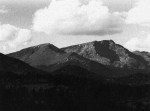by Nalini Nadkarni
The Marie Selby Botanical Gardens, Sarasota, Florida
The Canopy Studies workshop was organized to respond to the growing interest of LTER scientists in forest canopy studies, especially in gaining canopy access. The overall goal of the workshop was to initiate discussion on both inside- and outside-LTER Network needs for canopy measurements and research. A diverse group of scientists from 11 sites discussed related issues, including:
- Importance of canopy studies - what questions should/can be addressed in the canopy?
- Ongoing LTER (and other) efforts - what questions are currently being addressed?
- Canopy access techniques, including the proposed crane. Consensus was reached on these issues in the following areas:
- Canopy studies make up an important part of understanding long- term phenomena in ecosystems. A dearth of quantitative data exists because of the difficulty of access and the lack of a strong statistical basis for rigorous sampling and analyses. Important areas include:
- Development of sampling protocol and analyses
- Staging within- canopy micrometeorological studies, including measurement of gaseous, dry and wet deposition
- Documenting diversity and behavior of canopy biota
- Measuring tree architecture
- Validating canopy structure from remote sensing data
- Specific canopy studies being carried out (or planned/desired for the future) by scientists present included:
- Photosynthesis studies
- Vertical stratification of animals, including their distribution and behavior
- Validating canopy structure from remote sensing data
- Canopy structure and light extinction in the "air column" of the canopy
- Analyzing the role of epiphytes in forest nutrient cycles
- Mapping tree structure with surveying and computer graphics techniques
- To date, access to the canopy has been accomplished with a variety of techniques; for example, free-climbing, single-rope techniques, which are relatively inexpensive and safe, but do not provide access to the outer branches or upper crowns of most trees.
The possibility of installing large construction cranes in forests was discussed extensively. This tool could substantially increase canopy studies, including the ability to:
- Lift heavy instrumentation to the canopy, such as IRGAs, for process-oriented research
- Reside for long periods of time in the canopy for long-term observations of animal behavior and certain phenological phenomena\
- Provide total access to the trees and the three-dirnentional volume of the whole forest
- Provide access for those individuals who may not otherwise be physically able to get into the canopy
- Provide good “publicity” for fund-raising for forest canopy and other research
However, cranes are extremely expensive ($1.2 million to install and operate one machine), somewhat destructive to the immediate area of installation, and require considerable infrastructure to maintain. The example of the Smithsonian crane will be investigated to evaluate feasibility, costs, and benefits.
The workshop provided valuable contacts for future collaboration and highlighted the diverse interests, geographical locations, forest ecosystem types, and research questions that relate to the canopy. Further communication among participants and other LTER and outside researchers was encouraged.

 Enlarge this image
Enlarge this image